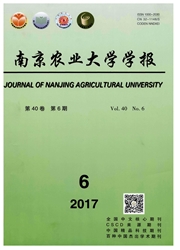

 中文摘要:
中文摘要:
以2个不同品质类型小麦品种为材料,研究了5个施氮水平下花后植株非结构性碳水化合物和氮素化合物的同化、转运及其相互关系。结果表明,花后氮同化量约为转运量的10%~40%,而花后碳同化量则为转运量的0.5~2.5倍。高蛋白品种豫麦47花后氮素和碳水化合物的转运量均较高,低蛋白品种豫麦50花后碳水化合物同化量较高。随施氮水平的提高,豫麦47的氮素转运量提高了45%,氮素同化量减少了84%,花后碳水化合物同化量提高了37%;而豫麦50的氮素转运量变化较小,氮素同化量减少了63%左右,花后碳水化合物同化量提高了63%,两品种碳水化合物转运量变化幅度较小。因此,适当提高施氮水平,对2种品质类型小麦可起到提高产量和改良品质的作用。
 英文摘要:
英文摘要:
The experiment was conducted to study the ralationships between assimilation and translocation of carbon and nitrogen after anthesis in two wheat eultivars under five nitrogen rates. The results showed that both amount of nitrogen transloeation and that of carbohydrate transloeation were higher in Yumai 47 with high grain protein content than in Yumai 50 with low grain protein content, whereas amount of carbon assimilation was higher in Yumai 50, and there was no significant difference in amount of nitrogen assimilation between Yumai 47 and Yumai 50. The ratio of nitrogen assimilation amount/nitrogen transloeation amount was ralatively low, accounting for 10% to 40% , whereas the amount of carbon assimilation accounted for more in amount of carbohydrate transloeation, with 0. 5 - 2.5 times higher than the amount of carbohydrate transloeation. With the increased nitrogen rates, the amount of nitrogen assimilation in two genotypes decreased, the amount of nitrogen transloeation increased by 45% in Yumai 47, but was stable in Yumai 50, and the amount of carbon assimilation increased 37% in Yumai 47 and 63% in Yumai 50. However, with the increased nitrogen rates, the amount of carbohydrate transloeation showed less change.
 同期刊论文项目
同期刊论文项目
 同项目期刊论文
同项目期刊论文
 期刊信息
期刊信息
